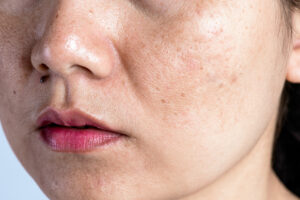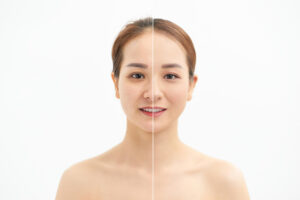CONTENTS

Unlocking the Secret: How to Tell Your Skin Type
There’s barely such a thing as one-size-fits-all when it comes to skincare. Different skin types require different levels of care and attention. But how to tell what type of skin you have?
Unlocking the secret to understanding your skin type doesn’t have to be a mystery. With a few simple steps, you can learn how to tell your skin type and provide it with the proper care it deserves. Check out our explanation about how to tell your skin type!
Basic Skin Types
Oily Skin

Oily skin type is characterized by shiny, greasy patches on the cheeks, chin, and forehead. This skin type can be caused by genetics, hormones, or environmental factors like stress, diet, and weather changes.
Sensitive Skin

Sensitive skin is the type of skin condition in which it reacts more quickly and intensely to outside factors, such as certain fabrics, lotions, and beauty products.
People with sensitive skin may experience burning or stinging when exposed to certain materials or temperatures. Symptoms of sensitive skin can vary in intensity from person to person, but some of the most common signs are dry skin, redness, itching, and hives.
Normal Skin

Normal skin is the typical type of skin found in healthy individuals. It typically has an even tone, a smooth texture, and few blemishes or imperfections.
This skin type does not tend to be too oily or too dry and can often tolerate most beauty products without irritation.
Dry Skin

Dry skin is a common condition characterized by a lack of moisture in the epidermis. It can cause itching, flaking, tightness, and redness. In some severe cases, dry skin may also lead to cracking, bleeding, or inflammation.
Causes of dry skin include:
- Environmental factors, such as cold temperatures or lack of humidity
- Medical conditions, such as diabetes or hypothyroidism
- Lifestyle choices, such as the use of harsh soaps or frequent bathing
Combination Skin

This type of skin sees areas that usually produce too much oil (like the T zone: forehead, nose, and chin) being offset by sections of the face that are drier.
It can be challenging to treat combination skin because it involves both oily and dry areas, but with the proper nourishment and care, it’s possible to get healthy-looking skin.
How to Determine Your Skin Type
The Bare-Faced Method

The Bare-Faced Method is an easy and effective way to determine your skin type. The steps include:
- Wash your face using a gentle cleanser and warm water, then pat your face dry.
- Wait for 30 minutes before applying anything else to the skin.
- Observe your skin during this period: if it feels tight, has shiny areas, or you see visible pores, you could have normal, combination, or oily skin, respectively.
- See if any redness appears after the 30-minute mark. If so, then sensitive skin might be the result.
- Finally, if none of these characteristics appear, you will likely have dry skin.
The Blotting Sheet Method

The Blotting Sheet Method is another easy way to determine your skin type. The steps are
- Use oil blotting sheets or toilet paper to absorb the surface oils on your skin.
- After dabbing the blotting sheet onto your face, you will be able to identify the amount of oil present on your skin, which can help determine whether you have dry, normal, oily, or combination skin.
You can use this method over time to detect any changes in skin types if you’re suffering from certain conditions that may cause such changes.
How to Care For Your Skin Types

Oily Skin
To control oily skin, you must maintain a consistent skincare routine with products specifically formulated for your unique type. Here are the tips to take care of oily skin:
- Use a gentle cleanser with an effective performance at removing excess oil without stripping away vital moisture.
- Look for products that contain natural ingredients such as aloe vera, green tea extract, and witch hazel, as this help to reduce inflammation and control oil production.
- Make sure you exfoliate with chemical peels or gentle scrubs designed specifically for oily skin types.
- Hydrate oily skin with light moisturizers that provide just enough hydration to balance out your natural oils.
- Opt for lightweight facial oils formulated specifically for oily-prone skin, or try blotting papers throughout the day to soak up excess sebum buildup.
Sensitive Skin
Sensitive skin can be challenging to manage and care for, but with a few key tips, you can make sure you’re taking good care of yourself.
- Wear sunscreen with at least SPF 30 and reapply throughout the day if you are in the sun for extended periods.
- Avoid fragrances in skincare products, laundry detergents, and air fresheners that can irritate if they come into contact with your skin. Try to find fragrance-free alternatives or use unscented products when possible.
- Cleanse twice daily to keep breakouts at bay using a gentle cleanser.
- Don’t overdo it on exfoliating products. Instead, use exfoliators sparingly and stick to gentle formulas like those made with jojoba beads or lactic acid instead of harsh ones like sea salt or sugar scrubs.
- Moisturize regularly with products specially designed for your sensitive skin so that your complexion stays hydrated and healthy-looking all day.
Normal Skin
Caring for normal skin is all about establishing a healthy daily routine. Here are some top tips to help protect your skin and keep it looking beautiful:
- Cleanse every morning and evening with an appropriate, gentle cleanser.
- Exfoliate once or twice a week. Make sure not to over-exfoliate, as this can make your skin worse!
- Apply moisturizer to lock in hydration and prevent dryness.
- Use sun protection every day with an SPF of at least 30. Make sure you apply it on all exposed areas (including the neck and hands).
- Avoid long hot baths and showers so you won’t strip natural oils away from the skin.
- Drink enough water every day to help keep your skin looking fresh and vibrant.
Dry Skin
Just like other skin types, dry skin needs proper care to keep it looking healthy and avoid flaky skin. Here are several tips:
- Keep your skin hydrated by applying moisturizers and drinking water.
- Use gentle cleansers on your skin to remove dirt, bacteria, and makeup without stripping off natural oils.
- Shower with lukewarm water; hot showers can strip off oils from the skin, leaving it feeling dry and tight.
- Exfoliate sparingly to remove dead skin cells that can cause flakiness and roughness.
- Wear sunscreen to protect your skin against UV damage which can lead to premature wrinkles and dryness.
- Moisturize daily using a gentle product for dry skin that contains ceramides or glycerin as the active ingredients
- Fix any underlying medical issues like thyroid disorders or diabetes that could be causing excessive dryness.
- Use humidifiers in winter months when the air is drier.
Combination Skin
Taking care of combination skin can be challenging since you have different skin types all at once. But with the proper method, it can be manageable. Here are some steps to get you started:
- Cleanse your skin twice a day using a mild cleanser. Avoid using harsh products containing alcohol, fragrances, or preservatives.
- Use a balancing toner after washing your face to help restore the skin’s pH balance.
- Moisturize your skin after cleansing and toning, using products specifically formulated for combination skin without weighing down the oilier areas of your face.
- Exfoliate sparingly to help remove dead cells from the surface of your skin and encourage new cell growth underneath. Choose gentle products for all types of skin, including sensitive areas around the eyes and nose.
- Use sunscreen with at least an SPF of 30 daily.
Frequently Asked Questions
Can my skin type change over time?
Yes, your skin type can change over time, particularly during hormonal changes like puberty or pregnancy. External environmental factors and lifestyle choices can also impact your skin types — such as too much sun exposure and harsh skincare products.
Is it necessary to know my skin type before buying skincare products?
Knowing your skin type is essential when choosing skincare products. Different types of skin require different ingredients and products, so understanding yours can help you create a customized routine that’s effective and safe.
Conclusion
So, there you have it! This how to tell your skin type guide will help you determine your skin type, and you can better tailor your skincare routine to fit your needs.
Just remember that everyone’s skin is different, so don’t be discouraged if you have to try a few products before finding ones that work for you. The most important thing is to understand how different products and ingredients affect your skin and go from there.
And, of course, consult a dermatologist if you’re unsure about how to tell your skin type. Have you determined your skin type? What products have worked well for you?


